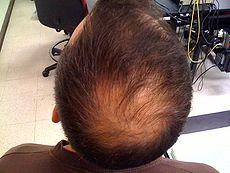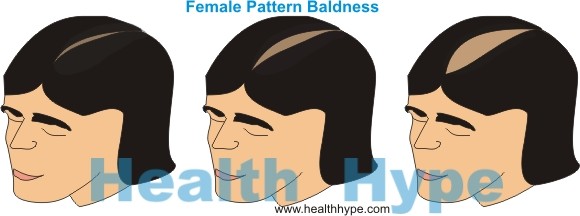Androgenetic Alopecia (Male-Pattern and Female-Pattern Balding)
The average human scalp loses about 100 strands of hair per day. This hair loss is normal and represents a very small potion of the strands present on the scalp. Sometimes hair loss becomes excessive and may affect the entire head (diffuse hair loss) or patches (focal hair loss). There are several different types and patterns of hair loss which is collectively known as alopecia or commonly as balding. The loss may be partial or complete, either temporary or permanent, and can extend to areas beyond the scalp.
The most common cause of balding is androgenetic alopecia which affects both men and women. It affects almost half of all men and may be just as prevalent among women over the age of 40 years old. Typically the first evidence of hair loss may be present from as early as the 30s and just continue, often gradually, over years and decades.
What is androgenetic alopecia?
Androgenetic alopecia (AGA) or androgenic alopecia is a hereditary pattern of hair loss associated with the action of the male hormones (androgens). It is commonly known as pattern baldness or more specifically as male-pattern hair loss or female-pattern hair loss depending on whether it affects men or women respectively.
Androgenetic alopecia is typically permanent and a gradual loss of hair in a characteristic pattern for each gender. Despite the advances in the medical treatment of alopecia androgenetic alopecia, the effectiveness is limited and more successful only in the very early stages. This is largely confined to slowing down the process.
Causes of Androgenetic Alopecia
The cycle of hair growth can be divided into three phases. Anagen is the active growth phase which lasts several years. During this phase, the hair follicles are constantly producing new cells which keratinize to form the hair shaft that is seen on the surface. Ideally the hair grows about 1 centimeter every 30 days. Most of the hair follicles on the scalp are in the anagen phase at any one time. After this period, the follicle goes through a transitionary period known as catagen.
Changes in the hair bulb prepare for the third stage which is a resting period. Telogen is the resting phase which lasts for several months where no active growth occurs and only about 10% to 15% of the hair follicles are in this state at any one time. Once telogen finishes, anagen starts again and the old strand of hair is often pushed out and shed at this point only to be replaced by the new strand. It is believed that in androgenetic alopecia the follicles become inactive permanently.
Genes and Hormones
Despite several theories, the exact mechanism of hair loss in androgenetic alopecia is not fully understood. It appears that a genetic predisposition causes the hair follicles to become extremely sensitive to androgens (male hormones), specifically dihydrotestosterone (DHT). Several sites on different chromosomes may code for the androgen receptor that is linked to the genetic sensitivity of the follicles in a person with androgenetic alopecia.
One of these sites is on chromosome X, and since it is autosomal recessive, it is therefore more likely to be seen in men. Nevertheless, studies have revealed that women may be just as prone to this type of hair loss although it is more diffuse and less severe than it is as men and may remain undiagnosed. There is a growing body of evidence to suggest that systemic disturbances and environmental factors may also play a role in the onset or progression of androgenetic alopecia.
Signs and Symptoms
Androgenetic alopecia is a non-scarring type of balding. There is no rash, itching of the scalp or associated features as is seen with certain other types of hair loss.
Male Pattern Baldness
The pattern of hair loss is more localized in men. Typically its starts with a receding hairline involving both sides of the temples (bitemporal recession) and then hair loss becomes prominent on the crown. In some men, the receding hairline and crown hair loss is limited so that there is only a more exposed forehead and a bald spot on the crown. The rest of the hair may be thin but is retained. In other men, the typical pattern is usually seen where the receding hairline is accompanied by the loss at the crown and eventually entire balding apart from the sides that are retained.
Hair loss, although limited, is noticed in the 20s and becomes more prominent in the 30s. Rarely does it start from the teens or cause complete loss in this period.
Female Pattern Baldness
In women the pattern of hair loss is not as distinct. The hairline does not recede and the loss is diffuse and more frequently reported as thinning hair. There may be complete loss (rare) or at least more prominent thinning (frequent) on the crown.
Hair loss is more prominent in postmenopausal women although it may start during the fertile years of life. It affects a small but significant number of women after the age of 40 irrespective of menopause.








